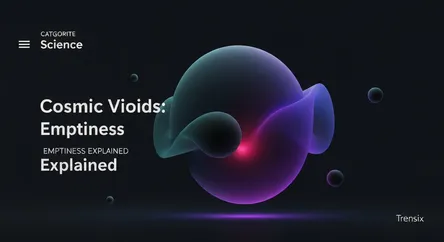Science
Cosmic Voids: Emptiness Explained

Discover cosmic voids, the vast, near-empty regions of space that shape the universe's structure. Learn why these massive expanses are key to cosmology.
What is it?
Cosmic voids are the largest structures in the universe. They are vast, underdense regions of space containing very few, or no, galaxies. These immense "bubbles" of near-emptiness stand in stark contrast to the filaments of the "cosmic web," where galaxies are concentrated. Spanning tens to hundreds of millions of light-years in diameter, voids make up the majority of the cosmos's volume. While not entirely empty—they are thought to contain dark energy, faint galaxies, and intergalactic gas—they provide a unique laboratory for studying the universe on its grandest scale.
Why is it trending?
Voids are a hot topic in cosmology because they hold clues to mysteries like dark energy and cosmic expansion. As the universe expands, voids grow, and their shape is sensitive to dark energy's properties. Advanced sky surveys are mapping voids with unprecedented precision to study this growth. By analyzing how light from distant objects travels through these empty regions (the integrated Sachs-Wolfe effect), scientists can test and refine fundamental models of the universe's evolution and composition, potentially shedding light on discrepancies in cosmic measurements.
How does it affect people?
Cosmic voids have no direct impact on daily life, but their study is crucial to understanding our place in the universe. Research into these structures drives technological innovation in telescopes and data analysis. It helps answer profound questions about the cosmos's origin, makeup, and ultimate fate. By challenging our models of gravity and cosmic evolution, the study of voids pushes the boundaries of scientific knowledge and inspires public fascination with the sheer scale and mystery of space, highlighting the vast, unexplored frontiers of our universe.